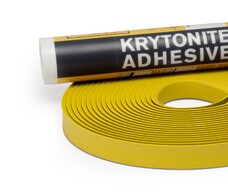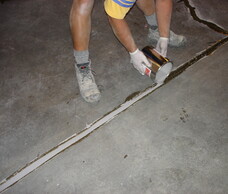Hydrophilic Waterstops and Joint Filling Material
Stratmore distributes hydrophilic waterstops for construction joints to stop the passage of water. We also manufacture epoxies for joint rehabilitation and repair.
Product
KRYTONITE
KRYTONITE Swelling Waterstop is a high performance elastomeric waterstop made from hydrophilic synthetic rubber. KRYTONITE delivers high performance waterproofing in a cost effective and easy to install solution. KRYTONITE uses swelling pressure to seal concrete construction joints and penetrations to stop water in the most extreme conditions. KRYTONITE is extremely durable and will not deteriorate over time. KRYTONITE does not contain bentonite.
What's it used for?
Use KRYTONITE Swelling Waterstop to permanently waterproof horizontal or vertical construction joints, pipe penetrations, between precast elements and other concrete joints. Use standard (yellow) KRYTONITE for all typical waterstop applications – including where salt and other water contaminations are anticipated. Use rain-protected (blue) KRYTONITE RP in wet environments where premature swelling is a risk.
What can it be applied to?
KRYTONITE is designed to replace moulded PVC waterstops and bentonite based waterstops in construction joints to prevent the passage of water through the joint. KRYTONITE can be used by itself as a single protection waterstop or with other components of the KRYSTOL WATERSTOP SYSTEM as part of a double protection system.
Limitations
Not for use at expansion joints. Do not use KRYTONITE RP in high-salt environments.
Apply to a dry surface and keep dry.
Do not place near the edge of the concrete. Leave a minimum concrete cover of 65 mm from all edges.
Product
HYDROTITE
HYDROTITE CJ 0720-2K is a hydrophilic (water swelling) material for site formed construction joints based on the proven effectiveness of HYDROTITE. HYDROTITE CJ 0720-2K has a composite structure: non expanding inner core with an expanding outer structure.
The holes of HYDROTITE CJ 0720-2K are designed to absorb expansion pressure during the initial stage of expansion and thus avoid cracking the concrete as it develops strength. The coating on HYDROTITE CJ 0720-2K delays premature expansion by rain or ground water before installation. The expansion delay coating also allows freshly poured concrete to cure before swelling occurs.
What's it used for?
HYDROTITE CJ 0720-2K is used to stop water from penetrating concrete construction joints, pipe penetrations and areas likely to allow water through. It is easy to install and does not contain Bentonite or other components that can leach out over time.
What can it be applied to?
HYDROTITE CJ 0720-2K is applied to the formed surface of a construction joint prior to the next concrete pour. It can also be wrapped around pipes prior to the pipe being embedded into new concrete.
Limitations
HYDROTITE CJ 0720-2K requires a minimum concrete cover of 100mm from all edges for unreinforced concrete or 50mm from all edges for reinforced concrete (HYDROTITE is placed within the reinforcement).
HYDROTITE should be protected from moisture or ponding of water prior to placement of concrete to avoid pre-expansion.
Product
LEAKMASTER
LEAKMASTER is a one-component water-swelling sealant for concrete construction joints and pipe penetrations.
Swells to over double its size when exposed to water.
What's it used for?
LEAKMASTER is used to seal rough and irregular joints or penetrations in concrete by swelling and applying pressure to the
surrounding concrete thereby stopping water from penetrating. LEAKMASTER can be used to bed HYDROTITE or KRYTONITE onto rough concrete.
What can it be applied to?
LEAKMASTER is applied to concrete or around pipe penetrations or steel to be encapsulated in concrete. LEAKMASTER can be applied underwater.
Limitations
LEAKMASTER requires a minimum amount of concrete cover depending on the bead size. For a large bead size, a minimum of 100mm cover (for unreinforced concrete) or 50mm (reinforced concrete) is required from all sides of the bead.
When applied, concrete cannot be poured until the LEAKMASTER is cured and resilient (can support weight).
Product
EPAR S
EPAR S is a low viscosity, lightly filled, high strength epoxy grout. EPAR S has very good mechanical properties and chemical resistance.
Available in a standard grade or as a FAST-SET/COLD-CURING version.
What's it used for?
EPAR S is used for filling spalls, cracks and chips in concrete floors and for grouting holding down bolts or starter bars into concrete.
It is also used for grouting under machinery, bearing plates, crane rails etc and as high strength nosings for bridges and industrial floors.
EPAR S FAST SET/COLD CURE is used for applications down to 0°C.
What can it be applied to?
EPAR S is applied to concrete and steel (bonding steel into concrete or under steel base plates/crane rails).
EPAR S may be used to level uneven and spalled concrete substrates not subject to moisture penetration through the substrate.
Limitations
EPAR S can be used to level existing concrete substrates. When used as a coating in this type of application, only experienced floor coatings applicators are to apply.
Product
EPAR 122 COLD CURE
EPAR 122 COLD CURE is an unfilled, non-shrink solvent-free epoxy liquid that is primarily used as a cold-curing concrete crack and joint repair system. It may also be used as a cold-curing primer for concrete surfaces prior to the application of other epoxy systems.
Cures down to 0°C
What's it used for?
EPAR 122 COLD CURE is also used as a concrete crack and joint repair system in low temperature applications. Common applications are the repair of cracked and spalling concrete joints in freezers or other low temperature storage areas.
EPAR 122 COLD CURE can be used as a primer for EPAR liquid epoxies and mortars when used on rough, absorbent surfaces at low temperatures.
What can it be applied to?
EPAR 122 COLD CURE is suitable for application to concrete substrates.
Limitations
EPAR 122 COLD CURE will cure down to 0°C. Initial and final cure times will be increased at lower temperatures (compared to testing at 18°C). Ensure epoxy is cured prior to opening to traffic.
At very low temperatures, warm the substrate (with hot air). Warm the epoxy hardener and resin (stand in hot water) prior to mixing and application.
Product
PLASTICAST LQB/LQG
PLASTICAST LQB is a two-part epoxy compound formulated specifically for use in bitumen and asphaltic surfaces. It is pigmented black. PLASTICAST LQB is internally flexibilised so as to allow differential movement without delamination, stress and cracking.
What's it used for?
PLASTICAST LQB/LQG is used to encapsulate road traffic light signal cable loops, saw cut joints, cracks and repairs, etc.
PLASTICAST LQG is typically used in concrete applications, with LQB used in asphaltic applications to more closely match the colour of the substrate.
PLASTICAST LQB/LQG has excellent (electrical) insulating properties.
What can it be applied to?
PLASTICAST LQB/LQG can be applied to asphaltic/bitumen and concrete substrates. It may also be applied to other substrates including concrete and steel (test for the intended application).
Limitations
PLASTICAST LQB/LQG is not suitable for application as a coating. For coating applications, please refer to EPAR 121B.
Not suitable for application to plastic substrates.
Information presented on this website must be read in conjunction with the latest technical datasheet, product label and any other application data.
Click here to download technical data





